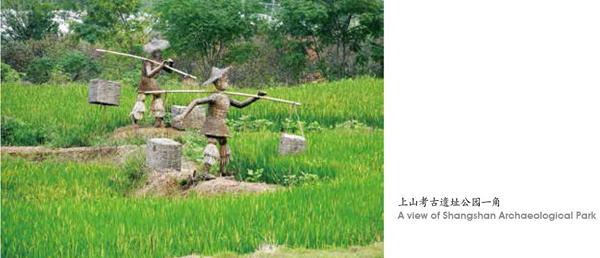萬年遺址,撩開神秘面紗
傅淑青
浙江浦江縣黃宅鎮渠南村,有一個隱在農居房中的公園——上山考古遺址公園。站在公園外往內看,陳設布置似乎簡單了些。但走進 A 和 B 這兩處上山遺址核心展示區,才發現別有洞天。在這里,不僅可以看到上山文化圖文并茂的精彩展示、觀賞到早期新石器時代的珍貴文物,還可以體驗萬年以前的稻作農業文化。

懷著對上山文化的興致,筆者多次在杭州與浦江之間往返,費盡心力,終于找到了上山遺址最初的發掘者、浙江省考古研究所研究員蔣樂平先生,以及多位知情者。他們為我撩開了上山文化的神秘面紗。
發現上山遺址之緣起
“說起浦江上山遺址,我想應從1996年的春天說起。那年我帶著所里的同志,為配合杭金衢高速公路建設,在沿線進行全方位的文物勘探。在諸暨次塢的樓家橋,我們發現了沿線唯一一處新石器時代遺址。可把我樂壞了。”憑著高度的職業敏感,發掘完三期樓家橋遺址的蔣樂平,馬上提出“浦陽江流域新石器時代遺址的調查與研究”課題,得到浙江省考古研究所大力支持后,立即投身于此。
2000年秋天,蔣樂平和團隊來到位于浦陽江上游的浦江縣黃宅鎮渠南村,這是他此行著重調研的點位之一。因為就在此處,有個當地政府保護了多年的遺址。在上世紀70年代末,此處曾出土過三足鼎以及石頭做的鋤頭、斧頭等勞作物件。但因鑒定困難,直至本世紀初,遺址依舊“養在深山無人知”。
蔣樂平在對該遺址做試探性發掘時,驚喜地發現了陶罐、陶豆等物品,并確定這乃是良渚時期的新時代石器遺址。同時在周邊發掘出同一時期、相同類型的墓地44座,據測算至今有4500年左右的歷史,非常具有歷史價值和研究意義。然而,更大的驚喜還在后面等著他。

蔣樂平和團隊把目標嘗試性地鎖定一個叫做“上山”的小山丘。當時的蔣樂平怎么都沒想到,這個看似普通、連地圖上都沒法畫出的小山丘,竟埋藏了“萬年遺址”;怎么都沒想到這一鋤下去,竟會讓上山遺址重見天日。可以說,這一鋤,直接改變了浙江的文明史!
那天究竟在上山發現了什么?雖已時隔十多年,蔣樂平記憶猶新。原來,他們挖到了炭紅陶片和磨制的石錛。無論從質地、工藝還是外觀看,這與良渚時期出土的新石器有著明顯區別。因為現場無法判定,蔣樂平只能保守地估計這兩個物件約有6000年的歷史。他告訴筆者,當時的確很開心,但并不知道這是萬年遺址,只是覺得運氣不錯,在一個小小的村莊,同時發現兩處新石器時代遺址,這在全省乃至全國都是很少見的。
長達七年的艱苦發掘之路
“霜如雪/工地待日出/又恐足下泥半截/今日不能歇//雨靴配陽笠/考古隊員稱一絕/刮地惜三分/打探地層聽消息……”蔣樂平一再笑稱,這是多年前即興而作的順口溜。從這簡短的50余字里,我們看到了考古隊員的真實工作狀態,也可以想象出其辛苦程度。
“無論烈日炎炎還是地凍天寒,只要一有時間,蔣先生都會帶著團隊,吃在上山、住在上山。”家住上山遺址附近的村民周成遠回憶,自2000年秋天發現上山遺址以來,蔣樂平一行人就開始了長達6年的跟蹤、挖掘、調查。皇天不負有心人!此后的幾年間,蔣樂平和團隊陸續發掘出了石球、陶器、建筑遺跡等具有新石器時代明顯特征的文物,其中大口盆、平底盤、雙耳罐等陶器,還羼和了一些稻殼、稻葉和稻莖。
2002年6月,蔣樂平取了四個夾炭陶片作為標本,請人轉交給碳14年代測定的專業機構——北京大學文博學院。2003年1月中旬,令人振奮的好消息傳來,這四個標本通過幾輪校正,測定到準確的時間約為9000—11000年!
“這意味著什么?!這是一個萬年遺址!而且,比蕭山跨湖橋遺址的年代早了2000~3000年,比余姚河姆渡遺址早了3000~4000年!”蔣樂平的興奮溢于言表。是的,上山遺址把浙江的史前文明足足往前推進了三四千年!興奮之余,蔣樂平又有些后怕。因為在發現上山遺址之前,這個在當地人看來沒什么用的小山丘,已列入2002年的土地平整規劃當中。假若來晚一步,上山遺址很可能被夷為平地。
同年11月7日,《中國文物報》頭版頭條刊登了蔣樂平撰寫的《浙江浦江縣發現距今萬年左右的早期新石器時代遺址》一文,引發不小的轟動。就這樣,上山遺址開始被學術界和社會各界廣泛關注,并被列入全國重點文物保護單位。
2005年年初,在嵊州的小黃山也發現了和上山遺址十分相似的文化類型,專家一致認為屬同種地域文化,并提議是否可將上山遺址和小黃山遺址所代表的遺存內涵命名為一種新的考古學文化?2006年11月5日,在浦江縣舉行的“中國第四屆環境考古學大會暨上山遺址學術研討會”上,把上山遺址為代表的新石器時代早期文化被正式命名為“上山文化”。
前人栽樹,后人乘涼。此后,在金華、永康、武義、龍游等地,又相繼發現并發掘上山文化遺址18處。這應當是迄今中國境內乃至東亞地區以“上山遺址”為代表的,規模最大、分布最為集中的早期新石器時代遺址群。
順勢而建上山考古遺址公園
為了使上山遺址不受自然天氣和人為破壞,2007年浦江縣曾在核心區的上方加蓋一個竹棚作為遮擋物。以前上山遺址并不對外開放,只用于專家、學者的觀摩和研討。

這些年,隨著上山文化聲名遠揚,當地政府越來越重視。顯然一個簡陋的竹棚已無法與其匹配,打造一個集參觀、展示、觀賞、體驗等功能于一體的場地非常有必要,這樣既對遺址核心區起到保護作用,為往后考古研究提供良好條件,又能把這些年發掘的成果直觀地展示給老百姓,帶動當地的休閑旅游,于是上山考古遺址公園的建設便提上了議程。
“上山考古遺址公園規劃面積為1206畝,于2016年6月正式動工。光第一期,我們縣里就投入了2730萬元的資金,通過5個月時間的緊張建設,完成了遺址公園第一期 A、B 兩館核心區的驗收工作”,浦江縣博物館館長朱江平如是說。
2016年的11月21日—24日,“‘上山文化命名十周年暨稻作農業起源國際學術研討會”在浦江舉辦。上山考古遺址公園正好以此盛會為契機,遂定于2016年11月22日正式開放的時間。值得一提的是,在此次會議上,國內外150余位專家學者對上山遺址的保護及陳展模式,給予了充分肯定。考古學界泰斗嚴文明先生還稱,可以把上山遺址保護工程,作為一個典范在全國樹立起來。
最令人欣喜的是,上山考古遺址公園自開放至今,老百姓的參與度一直居高不下。據遺址公園的工作人員洪信明和樓惠明介紹,據不完全統計,上山考古遺址公園迎來游客最多的一天約有6萬人。平時的人流量也不小,每天約有2000人次。來參觀的不僅是浦江境內的居民,還有很多慕名而來的外地游客和專家、學者。
朱江平館長對筆者說,為了更好地保護上山遺址、發掘上山文化,縣里還會繼續加大投入,以集遺址保護、文物展示、文物交流、教育科研、生態保護、休閑旅游為一體的國家考古遺址公園為規劃目標,將在遺址公園內打造“一帶五個區”,即蜈蚣溪濱水景觀帶和博物館及入口服務區、遺址展示區、農業及聚落展示區、濕地景觀區、休閑觀光區。
(本文照片由作者、蔣樂平、浦江縣博物館提供)
Shangshan Culture Site Park is now a huge tourist attraction in Pujiang, a rural county in central Zhejiang Province. Since the inception of the park on November 22, 2016, it has received a lot of visitors. The reception record is 60,000 visitors a day. The park averagely receives about 2,000 visitors per day. The site was first explored in 2000 by Jiang Leping, an archaeologist with Zhejiang Archaeology Institute, and his colleagues.

In 1996, Zhejiang was launching a highway project that would connect big cities across the province. Some experts from the institute were sent out to make archaeological surveys along the planned routes. Jiang and his colleagues found a Neolithic site in Zhuji, a county-level city near Pujiang. Aware of the importance of the discovery of the site, he proposed to search for other possible Neolithic sites along Puyang River. The proposal was approved.
Jiang and his colleagues began working diligently along the river. A key site he wanted particularly to explore was at Qunan, a village in Huangzai Town, Pujiang County. In the autumn of 2000, Jiang and his colleagues arrived at the site which had been under the protection of the local government since the late 1970s because of some stone tools unearthed there. Jiang conducted a trial excavation at the site and found some pottery pieces. To his ecstasy, he realized it was a Neolithic site, probably part of Liangzhu Culture. Near the spot where pottery pieces were discovered, he and his colleagues found a total of 44 tombs, which went back to 4,500 years ago.
Big surprises awaited them at a small hill called Shangshan nearby. Even now Jiang wows at the discovery. One digging hoe went down and the history of civilization of Zhejiang changed. They stumbled upon a reddish pottery shard with charcoal embedded in between and a hewn stone axe. Judging from the quality, texture, craftsmanship and appearance, these objects looked sharply different from those Neolithic objects unearthed from the sites of Liangzhu Culture. Jiang tentatively estimated that the two pieces were about 6,000 years old. He didnt know that what he and his colleagues found was a site of 10,000 years. He just felt lucky knowing that it was quite rare even in China that two different Neolithic sites were discovered around a small village.

In June 2002, Jiang Leping sent four pottery shards as specimens to Peking University to determine the age of the pottery pieces. The results came back in January 2003. Radiocarbon dating confirmed that these four pieces were 9,000 to 11,000 years old.
Jiangs ecstasy knew no bounds! He knew what it meant: It means it was about 2,000 to 3,000 years older than the Kuahuqiao Site in Xiaoshan and about 3,000 to 4,000 years older than Hemudu Site in Yuyao. It pushed back the history of prehistoric civilization in the province by 3,000 to 4,000 years. He hugged himself for good luck: the useless hill had been included in a development project to be started in 2002. Had he and his team been somewhere else, the site would have been gone forever.
On November 7, 2002, his report on the site was published on the front page of China Cultural Relics News, a national newspaper perused by archaeologists across the country. The report caused a big sensation. The site was listed as a key cultural relic site under the protection of the national government.
In early 2005, a similar site at Xiaohuangshan in Shengzhou was discovered. On the grounds that the Xiaohuangshan site and the Shangshan site belonged to the same regional culture, experts proposed to have a new name for the culture. On November 5, 2005, it was officially named Shangshan Culture. Today, another 18 sites scattered in counties and cities in this part of the province have been added to the Shangshan Culture. It is the largest group of early Neolithic sites in East Asia. Evidence indicates that the people back then were engaged in rice farming.
In 2007, the local government set up a bamboo structure over the archaeological site for protection and only experts were permitted to visit. In June 2016, a large project started to build a park. In five months, the project was concluded. On November 22, 2016, the park opened to the general public.

